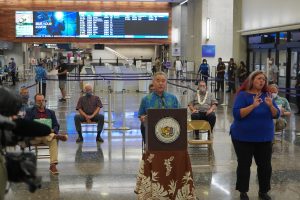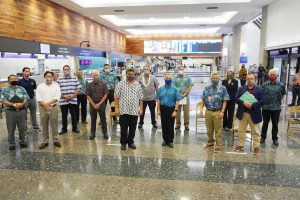New travel guidelines as the state moves forward
Posted on Jun 26, 2020 in Capitol Connection, FeaturedHawai‘i has been called “a rare COVID-19 success story” among states because of how we’ve managed the pandemic. So how do we keep our case counts low as we open for more business and traveler activity? And how do we help local residents and the economy recover as we figure out our “new normal”? Those are some of the tough questions the state is grappling with as it looks to the future.
Q. What do you want people to remember as the state opens for more activity? What safeguards do we have in place?
A. We know the coronavirus spreads through face-to-face transmission, which is why physical distancing, masks and washing hands are still so important. Our system of screening, testing and contact tracing is working, but we can only be successful if people take precautions. Larger groups increase the probability of infection. Our success so far has meant we were able to lift the quarantine on interisland travel. Now, we need to welcome visitors in a safe and healthy way for the sake of our economy and people’s jobs.
Q. What more can you tell us about the new protocols for interisland and trans-Pacific travel?
A. So far, interisland travel without quarantines seems to be going smoothly. Our plan for trans-Pacific travel says that starting Aug. 1 we will implement a pre-travel testing option for travelers arriving in Hawai‘i from out-of-state as an alternative to the 14-day quarantine. Travelers can get a valid COVID-19 PCR test prior to their arrival and show proof of a negative test result to avoid the 14-day quarantine. We’re also continuing to work on developing travel corridors or “travel bubbles” between countries such as Japan and South Korea. It’s all about trying to minimize risk, but it will never be zero risk.

Governor Ige thanks community partners and the people of Hawai‘i for working together during this challenging time.
Q. Why is it important to welcome more visitors soon? What do you think tourism will look like with the “new normal”?
A. If we can’t find alternatives to the quarantine for trans-Pacific travelers, then our unemployment rate will continue to be 22 percent. Clearly, a lot of local businesses rely on the visitors who used to come to our islands, so we have to find a balance between safety and restarting the economy. Hawai‘i is one of the safest places on Earth for COVID-19, and we want to keep it that way. We need to “reimagine” tourism so visitors can be respectful of native Hawaiian culture, the environment and our public health.
Q. How are you and the Legislature deploying CARES Act funds and addressing the projected $2.3 billion state budget deficit?
A. We’re looking at ways CARES Act money can help local residents with rent, unemployment benefits, and other basic needs as well as distributing funds to the counties. As for the budget shortfall, we have a lot of hard decisions to make as a state. I’ve already called for hiring and spending freezes and asked state agencies to identify additional cuts. We’ve taken out a federal loan to cover unemployment benefits and will be applying for another loan from the U.S. Treasury, but we are still short. Since it doesn’t look like we’re going to get any additional federal help, the last option would be pay cuts and furloughs.
Q. Why did you and mayors issue your strong statement on racial injustice after the killing of George Floyd?
A. We felt it was important to acknowledge the hurt and pain felt in the black community and by many minorities in this country. President Trump, on the other hand, was telling mayors and governors to crack down hard on the protests. On a call to the White House with other governors soon after George Floyd was killed, I was horrified that there was no acknowledgment by the president of hundreds of years of racial discrimination. He seemed more interested in arming up and “dominating the streets.” When one governor suggested that the country needed a call for unity, he (Trump) ended the call in disgust.
